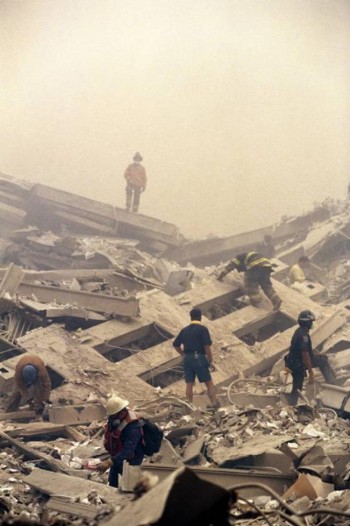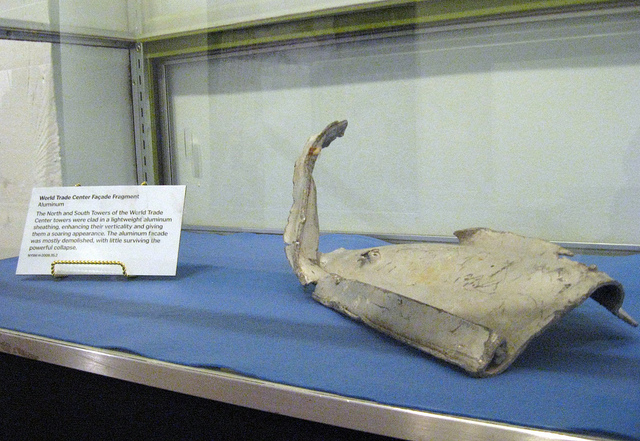Short Fuse Commentary: Art and 9/11
What percentage art? What percentage terrorist attack?
Here Is New York: Remembering 9/11. The New York Historical Society, 170 Central Park West, New York, NY, 2007.
By Harvey Blume.
Originally posted on October 1, 2007.
The New-York Historical Society is currently hosting a show marking the sixth anniversary of the attacks on the World Trade Center (Here Is New York: Remembering 9/11).
Consisting mostly of emotionally wrenching photographs taken during or immediately after the attacks, the show also includes several objects worth pondering. Two that held my attention were “World Trade Center I-Beam Fragment,” and “World Trade Center Aluminum Facade Fragment.”
The latter, especially, was beautiful. With its tortured grace, as if caught in a contorted dance step, it was the sort of thing any number of contemporary sculptors would be proud to have made. Though it was forged in the 9/11 nightmare, it’s impossible to deny its aesthetic likelihood. That, of course, ushers in the next question, should you choose to entertain it: But is it art?
As a friend pointed out, “World Trade Center Aluminum Facade Fragment” had been vertically mounted on a steel pedestal, with both edges of the salvaged piece finely shaved off. The pedestal made it viewable, gave it art object sparkle. It turns out the sculptor Richard Webber, in his Brooklyn studio, had come up with the steel mount “after communing” at length with it and other artifacts from Ground Zero. Webber told The New York Times that by contemplating these artifacts, “you could almost hear what happened that day.”
However, Louise Mirrer, the president of the New York Historical Society, insisted on placing obstacles in the way of viewers thinking about these objects as art. She stressed that “they are the product of impacts, and of heat—the remains of a massively tragic event.”
Of course, that’s true, massively. But is there really any danger of visitors to this exhibit forgetting that? There are tissue dispensers placed strategically for those who, as it’s hard to resist doing, succumb to too much emotion.
Product of impact and heat, “World Trade Center Aluminum Facade Fragment” is also, in the way it’s been reclaimed and presented, the product of artistic inspiration. Bluntly, it is the product of Al Qaeda and a pedestal.
What percentage art?
What percentage terrorist attack?
Somewhat the same thought process applies to “World Trade Center I-Beam Fragment” a rusty piece of ruined steel, rebar literally shot through with history, i-beam with holes in it.
Looking at it made me rethink Richard Serra, whose new installation of massive, gorgeously curved, impossibly positioned, ruinously expensive steel was lately at the MoMA. Serra is the Brancusi of our day and age, the maker of somewhat (repetitively) perfect things.
I like wandering through Serra’s steel mazes. I like stroking their surfaces, though for god knows what reason doing so is forbidden. I like seriously whacking the hollow constructions when neither guards nor other visitors are looking. They are drums. They are fantastic gongs.
I don’t think Richard Serra’s work would suffer from being, occasionally, shot through with holes.
However inadvertently, Here Is New York: Remembering 9/11 is aesthetically suggestive.
Tagged: MoMA, New-York-Historical-Society, Richard-Serra, Richard-Webber, Short Fuse, Visual Arts


